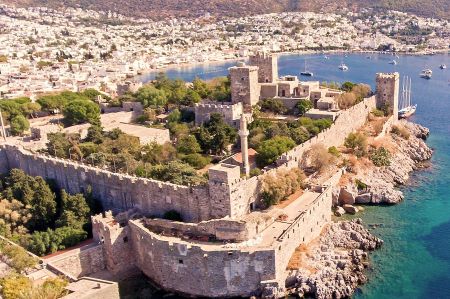Bodrum Castle - surrounded by Marina
- Written by Portal Editor
The construction of Bodrum Castle was begun in 1406 by the Knights of Saint John. It was built on top of the old Turkish and Byzantine castles and given the name of Saint Peter. The construction of the castle continued until 1522.
Bodrum Castle, which is the strongest castle in the Mediterranean, rests prominently on the rocky peninsula between two harbours and measures 180 x 185 metres.
Bodrum Castle, once the strongest fortress in the entire Mediterranean
The inner castle, which can be reached by passing through seven gates, is like a natural park with its flowers, cacti, shrubs and plenty of doves and peacocks wandering around.
The small chapel of Gothic style is now an exhibition hall containing a replica of a sunken Byzantine vessel from the 7th century AD.
The Chapel was converted into a mosque in 1523 during the reign of Sultan Süleyman the Magnificient.On the left side of the chapel is the Turkish bath. If you follow the path to the left the Amphora Park will be seen. The building you reach after the Amphora Park is the Glass Exhibition Hall. The objects here date from the 14th century BC to the 11th century AD. They were excavated from under the sea and underground and are displayed in a mystical setting of low lighting.
When you pass through a Gothic style vaulted passage, the Queen of Caria awaits you with her precious crown jewels. She is believed to have died at the age of forty. It is not definite how long she ruled as the Satrap, but it is certain that her relationship with the visitors to Bodrum castle will last forever.
The torture chamber with all its instruments
There are five major towers in the castle which were built by different nations. One of these is the English Tower(also known as the Lion Tower). This is the most impressive and biggest monument, with a Medieval setting, constructed by the English outside of Britain. The coat of arms and the banners on the walls will swiftly take you back in time to the Middle Ages. The German (or Strong) Tower is decorated like the English Tower to illustrate the life style of the knights of the Middle Ages. It reflects the three phases of existence: birth, life and death.
The others are the French (Lace) Tower, Spanish (Snake) Tower and the Italian (Relief) Tower. The Dungeon, with its torture chamber portrays all the horror of the Middle Ages.
Throughout the castle there are 249 coats of arms on the walls which are like signatures depicting the dates of renovations and additions made to the castle throughout its history. These coats of arms belong to the Grand Master (Magnus Magister) and his castle commanders.
On the northwest side of the castle there is a large area where festivals and concerts are held and theatre plays are staged.
Bodrum Castle was taken by the Turks on January 5th 1523, without a fight, from the Knights of Saint John after their conquest of Rhodos.
During the Knights of Saint John period, Bodrum Castle probably held about 50 knights and 150 soldiers .
During the Ottoman period , the castle lost its importance because the country’s borders extended all the way to central Africa.The castle was governed by a Dizdar (Warden) and a company of 60 soldiers.
In 1895 Bodrum Castle became a prison, housing 700 prisoners and 50 guards.
On May 26th 1915, during the First World War, the castle was bombed by the French battleship Duplex.
Until 1960 the castle was used for storing artifacts. In 1964 it became a museum, which now houses the world’s largest collection of artifacts from underwater excavations.
Please read as well:
Gaziemir - developing suburb of Izmir
Podgorica – today the cultural centre of Montenegro
-
 Bodrum Castle and its lovely Marina
Bodrum Castle and its lovely Marina
Bodrum Castle and its lovely Marina
Bodrum Castle and its lovely Marina
-
 Bodrum Castle and its lovely Marina
Bodrum Castle and its lovely Marina
Bodrum Castle and its lovely Marina
Bodrum Castle and its lovely Marina
-
 Bodrum Castle and its lovely Marina
Bodrum Castle and its lovely Marina
Bodrum Castle and its lovely Marina
Bodrum Castle and its lovely Marina
-
 Bodrum Castle and its lovely Marina
Bodrum Castle and its lovely Marina
Bodrum Castle and its lovely Marina
Bodrum Castle and its lovely Marina
-
 Bodrum Castle and its lovely Marina
Bodrum Castle and its lovely Marina
Bodrum Castle and its lovely Marina
Bodrum Castle and its lovely Marina
-
 Bodrum Castle and its lovely Marina
Bodrum Castle and its lovely Marina
Bodrum Castle and its lovely Marina
Bodrum Castle and its lovely Marina
-
 Bodrum Castle and its lovely Marina
Bodrum Castle and its lovely Marina
Bodrum Castle and its lovely Marina
Bodrum Castle and its lovely Marina
-
 Bodrum Castle and its lovely Marina
Bodrum Castle and its lovely Marina
Bodrum Castle and its lovely Marina
Bodrum Castle and its lovely Marina
-
 Bodrum Castle and its lovely Marina
Bodrum Castle and its lovely Marina
Bodrum Castle and its lovely Marina
Bodrum Castle and its lovely Marina
-
 Bodrum Castle and its lovely Marina
Bodrum Castle and its lovely Marina
Bodrum Castle and its lovely Marina
Bodrum Castle and its lovely Marina
-
 Bodrum Castle and its lovely Marina
Bodrum Castle and its lovely Marina
Bodrum Castle and its lovely Marina
Bodrum Castle and its lovely Marina
-
 Bodrum Castle and its lovely Marina
Bodrum Castle and its lovely Marina
Bodrum Castle and its lovely Marina
Bodrum Castle and its lovely Marina
https://www.alaturka.info/en/turkey-country/aegean/1580-bodrum-castle#sigProId6fa5f0c28d

